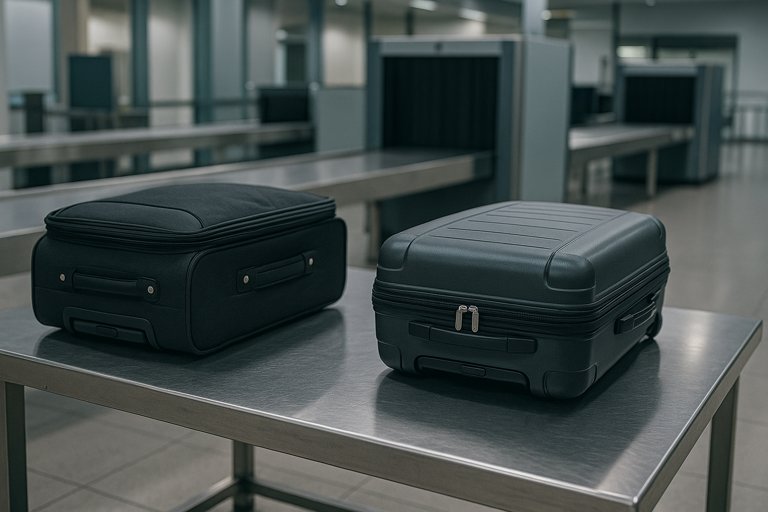Authorities at Toronto Pearson International Airport detained two women after discovering more than one million dollars’ worth of undeclared currency concealed inside their suitcases during a routine customs inspection. According to officials, the passengers had arrived on an international flight and were referred for additional screening based on discrepancies in their travel declarations. What began as a standard assessment quickly escalated when officers noticed unusual weight distributions and inconsistent packing patterns inside both pieces of luggage.
During the search, officers uncovered a significant sum of cash distributed throughout the suitcases. The money was hidden within layers of clothing, personal items, and other belongings in an apparent attempt to avoid detection. Officials reported that the total amount consisted of 982,000 Canadian dollars and 186,000 euros, a combination that immediately raised concerns about possible financial misconduct. The passengers provided no documentation to justify carrying such substantial sums across international borders.
Canadian law requires travelers to declare amounts of currency or monetary instruments totaling 10,000 dollars or more when entering or leaving the country. This regulation exists to prevent money laundering, tax evasion, and other financial crimes that can undermine public institutions and legitimate economic activity. In this case, authorities stated that neither woman filed the mandatory declaration, despite having multiple opportunities to do so before arriving at the inspection area.
Officials emphasized that failing to declare large amounts of cash does not automatically imply criminal intent. Travelers may carry significant funds for personal, business, or family reasons. However, what triggers concern is the deliberate omission of required paperwork combined with efforts to conceal the money. In this incident, officers noted that the banknotes were dispersed in a manner consistent with attempts to disguise their presence from routine baggage screening procedures.
After the discovery, the Canada Border Services Agency initiated standard protocols, including documenting the recovered funds, interviewing the passengers, and verifying their travel histories. Authorities also contacted relevant financial intelligence units to assess whether the seized currency could be linked to broader investigations. While the findings alone do not confirm illegal activity, the circumstances surrounding the concealment prompted further scrutiny from specialized teams trained to handle complex monetary cases.
The passengers were reportedly cooperative but offered inconsistent explanations about the origins and intended use of the money. Officers noted disparities in their statements, particularly regarding how long they had been traveling together and who was responsible for packing the suitcases. Such inconsistencies, while not unusual in high-stress situations, often contribute to decisions about whether further investigative steps are warranted or whether additional authorities should be contacted.
Airport routines continued unaffected as the inspection unfolded in a secured area, away from the public eye. Travelers passing through the terminal remained unaware of the situation, illustrating how often significant enforcement actions occur behind the scenes. Officials highlighted that these types of discoveries, while not daily occurrences, happen more frequently than many passengers realize due to the volume of international traffic moving through Toronto Pearson each year.
Experts in cross‑border financial enforcement note that undeclared cash seizures are part of a broader pattern seen in major airports worldwide. The motivations vary widely, ranging from misunderstandings of reporting requirements to deliberate attempts to bypass financial systems. Authorities in Canada routinely issue reminders to travelers, especially during peak travel seasons, that transparency with customs officials is the simplest way to avoid serious consequences.
The seized funds are currently being held pending further review, a process that may involve detailed financial tracing to determine their origins. Officials stated that the women could face penalties, including forfeiture of the money, fines, or additional legal consequences depending on the outcome of the investigation. The goal, they emphasized, is not only to enforce regulations but also to safeguard the integrity of Canada’s borders and financial systems.
Legal experts explain that individuals in similar situations may eventually be required to provide documentation proving lawful ownership of the funds. This can include bank withdrawal records, business contracts, or inheritance papers. Without clear evidence, the likelihood of permanently losing the undeclared money increases substantially. In some cases, travelers are granted an opportunity to appeal penalties, but outcomes depend heavily on supporting documentation and cooperation with authorities.
Despite the seriousness of the incident, officials reiterated that travelers transporting large amounts of money are not prohibited from doing so. The critical requirement is that the funds must be declared truthfully and accurately. By failing to comply with these straightforward regulations, individuals risk creating complications that can overshadow legitimate reasons for carrying substantial cash across borders.
The investigation remains ongoing as authorities continue to review the circumstances and gather additional information. While no charges have been announced at this stage, officials stressed that the case underscores the importance of adhering to customs declaration rules. For now, the seized currency will remain in government custody until investigators determine the appropriate next steps, offering a clear reminder to travelers of the consequences of non‑compliance.
